TCL 10 Pro Review
TCL 10 Pro Review
A mid-priced marvel – but invest in a case
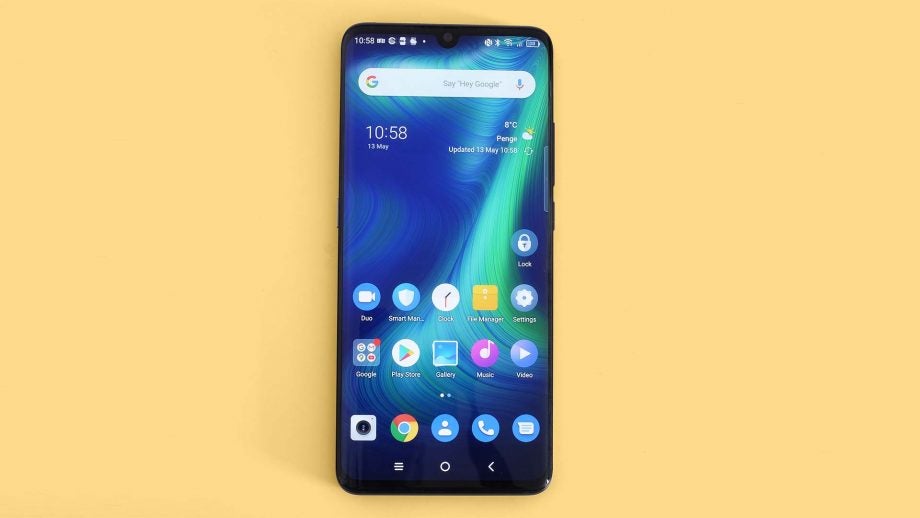
Verdict
Th TCL 10 Pro is an attractive mid-price phone with a great screen. It’s a decent buy as long as you moderate your expectations of the camera and battery life
Pros
- High-quality design
- Feels fast
- Has a headphone jack
- Excellent OLED screen
Cons
- Battery underperforms
- Rear finish is easy to scratch and scuff
- TCL interface needs tweaks to feel normal
- Fairly poor low-light images
- Unsubtle camera image processing
- No 5G
Key Specifications
- Review Price: £399.99
- Qualcomm 675 CPU
- 6GB RAM
- 128GB storage
- 4500mAh battery
- IR blaster
- 64/16/5/2MP rear cameras
- 24MP selfie camera
The TCL 10 Pro is similar to a OnePlus device, in that it looks like a high-end mobile, but without the accompanying high price. In fact, right now it’s £200 cheaper than the OnePlus 8 at £399.
While the name maybe unfamiliar to the majority, you’ll certainly have come across some of the products TCL makes.
As well as being responsible for production of BlackBerry phones of the past few years, TCL also makes Alcatel phones under license. The company also manufactures a number of TVs. Hence, TCL is no tech newbie; it’s a Chinese giant. However, this is the first time we’ve seen a TCL phone marketed as such and sold along western shores.
The good news is that, for the £399 price, this phone looks and feels fantastic. General performance is excellent, the core hardware hasn’t seen any major cut corners, a headphone jack is included, and the screen is great.
However, the TCL 10 Pro doesn’t offer 5G, the gorgeous matte-glass rear of the device is too easy to damage, the interface requires some tweaking to get it just right, and camera processing could do with a lighter touch. In addition, the TCL 10 Pro faces strong competition from the Xiaomi Realme 6, which is cheaper.
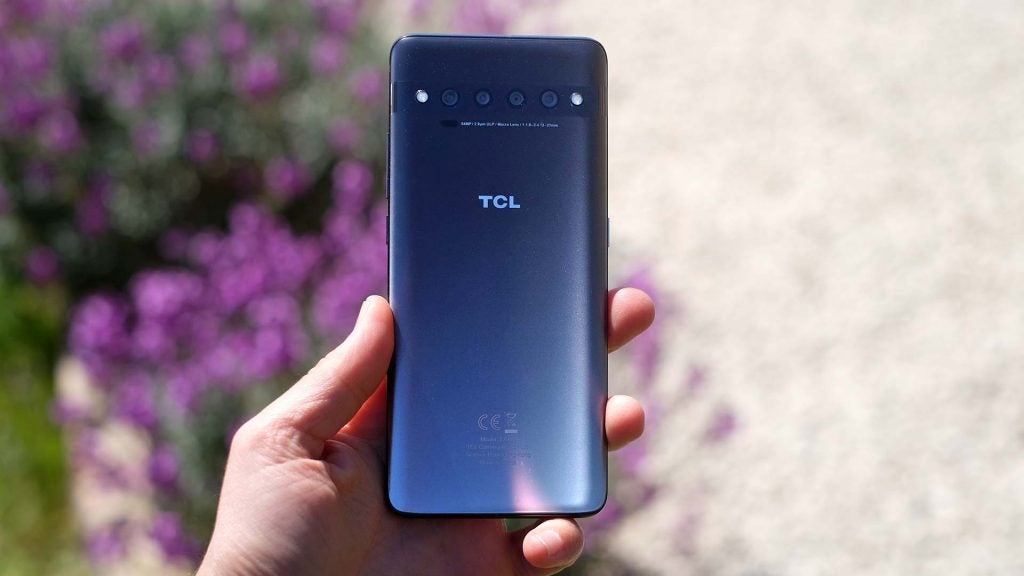
TCL 10 Pro design – A quality finish, with glass front and back
Today, you won’t find many phones at £400 that feel as expensive as the TCL 10 Pro. This is especially true now that models such as the Motorola Moto G8 Plus come sporting plastic rears.
The TCL 10 Pro features genuine glass front and back panels, with aluminium sitting between. The glass used here is Gorilla Glass 5, and both back and front have a true curvature that’s far beyond the 2.5D glass you usually see at the price. The latter is usually little more than flat glass with rounded-off edges.
The result is a device that looks and feels fantastic, particularly given the price is now considered somewhere in the lower regions of “mid-range”.
I’m particularly enamoured by the TCL 10 Pro’s rear finish. The back is matte, interrupted only by the strip that holds the cameras, and sports a subtle gradient. Silver at the bottom becomes black at the top. TCL’s decision to arrange the cameras in a line, creating symmetry with two separate LED flashes, is also a nice touch.
It was only following two weeks with the device that I discovered an issue with the TCL 10 Pro design. The rear finish is too easy to scratch, and the phone doesn’t come with a case or a screen protector.
In addition, the almost flat rear means the cameras sit on the same pane of glass as the rest of the rear, and this too is concerning. However, those two LED flashes aren’t just for show. Their plastic caps sit a fraction above the glass, which means when resting on its rear, the phone is actually sitting on these caps. Potential crisis averted.
All of the TCL 10 Pro’s side buttons are metal; there’s no sense this is a “cheap” Chinese phone – which can be the case with devices from smaller brands such as Doogee and Cubot.
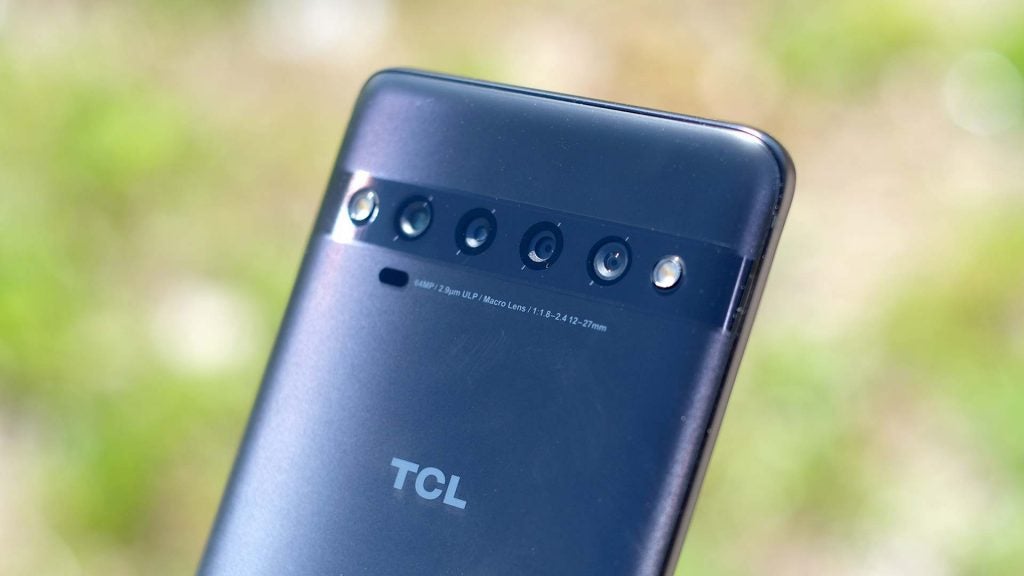
The TCL 10 Pro comes with a few rare extras, too. A 3.5mm headphone jack sits along its top, alongside an IR blaster. Used in conjunction with the IR Remote app, it allows the phone to replace remotes for your TV, home cinema receiver, anything that uses an IR signal.
I’m pleased to report that it works well, with the app having lots of presets for popular UK and US brands.
The TCL 10 Pro also has an in-screen fingerprint scanner. In use it proved patchy until the day before this review was first published, when TCL fixed issues via a software update. Now I’d consider it one of the very best finger scanners I’ve seen in a mid-range phone. Quick and fairly reliable, there are no complaints here.
So what’s missing? The TCL 10 Pro is lacking any official water-resistance, and the phone’s speaker inclusion is only mono.
In addition, one of the TCL 10 Pro’s side buttons is rather annoying. On the right you’ll find standard power and volume buttons; a Google Assistant button sits on the left side. The issue is that it’s all too easy to accidentally depress the latter in your pocket, bringing up Assistant when the phone is asleep.
And to prove my point, I’ve done this approximately 864 times to date. Thankfully, there is an option in Settings that allows Assistant to be evoked only via a long press. I recommend using it.
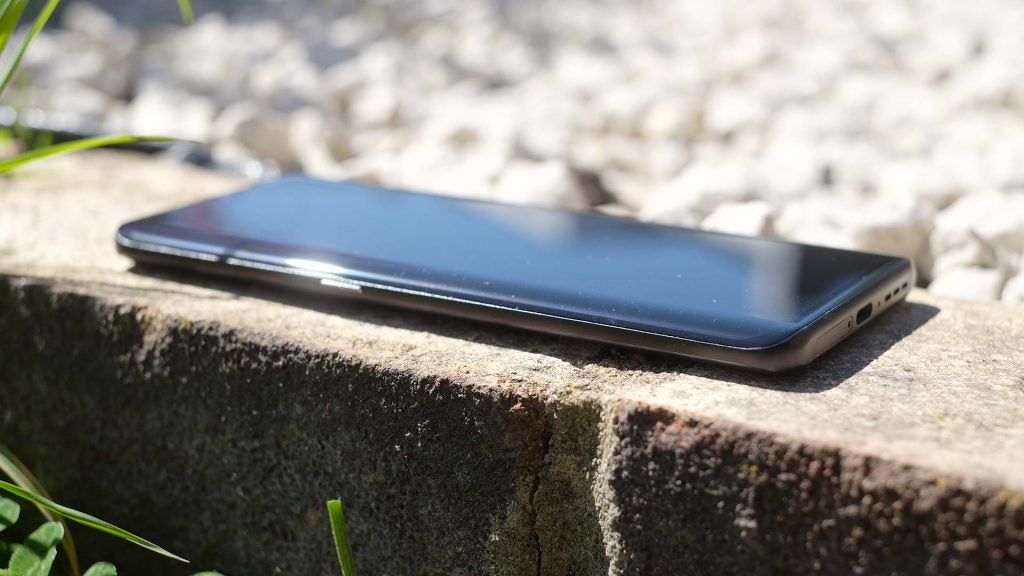
TCL 10 Pro screen – Vibrant colours, superb contrast and excellent brightness
The TCL 10 Pro’s 2340 x 1080 pixel OLED screen is a highlight. While it may not be quite up to the standards of the Samsung Galaxy S20 Ultra’s display, it has all of the same basic hallmarks.
Contrast is predictably superb, motion handling is excellent, colours are vibrant and top brightness is sufficient for decent clarity on sunny days.
There are subtler signs of the TCL 10 Pro’s display quality, too. Curved OLED displays can leave a phone with edges that look dimmer than the rest, but the effect is minimal here. There’s also very minor shift in colour tone when viewed from an angle. Less advanced OLED screens can take on a blue tint when they’re not viewed dead-on.
None of the certification essentials are missed, either. The TCL 10 Pro can already stream HDR and HD Netflix (you’d assume this is a given, but it isn’t) and HDR YouTube videos.
TCL puts its own spin on screen optimisation, too: Nxtvision. This is really just a fancy name for the part of the Settings menu that lets you customise the display, but it does include some neat features.
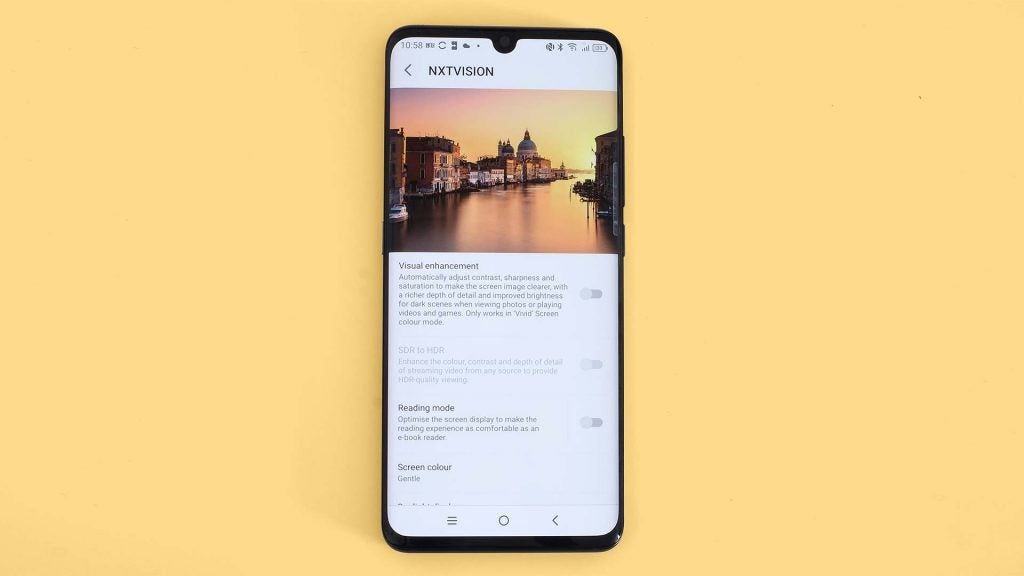
There are colour character presets (choose your vividness level), an SDR-to-HDR converter filter and Reading mode. With the latter you choose for apps to run in a warm, low saturation mode – which, I suppose, is meant to be easier on your eyes.
One recommendation I do have is using the TCL 10 Pro’s Gentle colour mode. This phone doesn’t behave differently in the Gallery, so if your colour profile is an extra-saturated one, then your photos will look that way too. As such, a photo viewed on your Instagram account will appear more vivid on your phone screen compared to how it’s seen on someone else’s device. That’s a no-no.
Handsets from Samsung, for example, offer smarter screen calibration that ensures your photos appear true-to-reality no matter the colour mode used.
Screen-wise, this is the only part of the TCL 10 Pro’s setup that I’ve found disappointing.
The phones maximum brightness of 600 nits is nowhere near the Samsung Galaxy S20 Ultra’s 1300-odd. Resolution is much lower, too. Nevertheless, the screen is sharp and bright enough to be usable on super-light days, lowering the real-world impact of these differences.
It’s a cracker of a screen at the price, and better than that of the Samsung Galaxy A51.
TCL 10 Pro software and performance – An initial tweak of the interface will make life easier in the long-run
The TCL 10 Pro runs Android 10 with a software layer on top called, imaginatively, TCL UI.
Initial reactions can be summed up as, “Oh my, this is trash.” However, I quickly learned that in only a few taps of the screen I was able to undo the weird default setup of this interface.
First to be changed was the app menu layout. It comes arranged by category as standard, which is completely impractical. Your app drawer ends up being three miles long, with half of your apps ending up in an “other” category. Handy.
Switch the app screen to order alphabetically and suddenly TCL UI starts to look as good as most other interfaces.It’s also possible to order apps by icon colour. It’s looks attractive – but, again, it’s simply impractical.
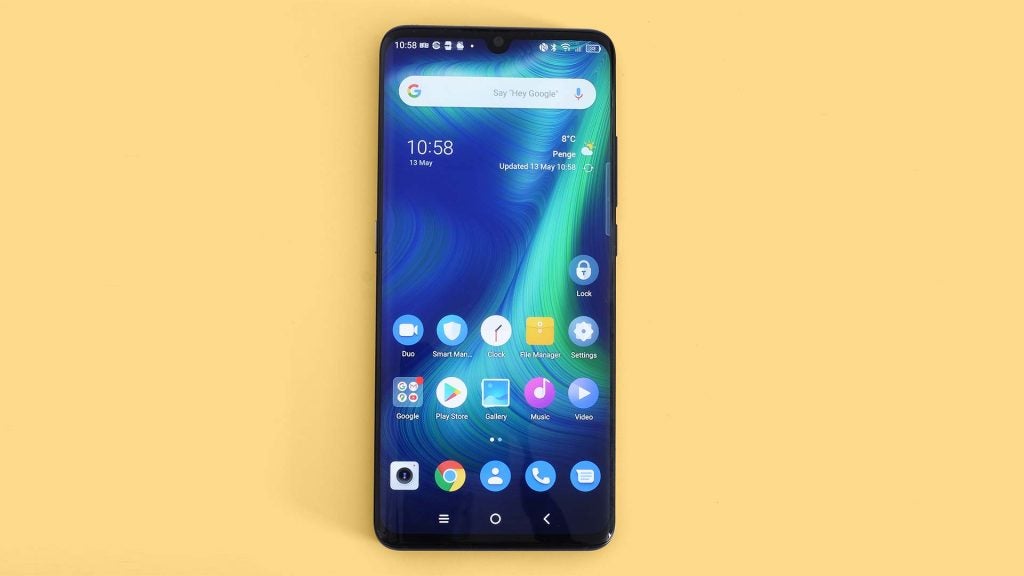
I also recommend maxing out the number of app rows and columns. This is a big screen, fully capable of handling the extra icons.
Other parts of the TCL 10 Pro interface are also impressive, not showing any signs of TCL over-reaching to add a distinctive character to the phone. There’s an extra homescreen, but it’s just the standard Google feed. The Settings menu is simple enough to navigate and while the lock-screen is a TCL design, you can switch to the standard Google-style one if you prefer.
So, first impressions of the TCL 10 Pro software maybe poor, but the issues are really surface-level. It took only two minutes of tweaking to knock the interface into a shape I actually like.
General performance, too, is excellent. I saw far more responsive transitions and much lower lag than I experienced the week before using the Samsung Galaxy A51. The TCL 10 Pro has a snappy feel not dissimilar to a true high-end phone.
TCL 10 Pro performance – Super snappy
And to achieve that snappy performance, the TCL 10 Pro doesn’t include any extraordinary hardware. The device has a Qualcomm Snapdragon 675 processor accompanied by 6GB of RAM, which is slightly better than the Google Pixel 3a XL‘s Snapdragon 670.
The CPU in the TCL 10 Pro is relatively old, announced back in 2018. The Snapdragon 730G is an obvious newer alternative, and can be found in the Xiaomi Note 10.
But is it actually better? The TCL 10 Pro scores 1573 in Geekbench 5, compared to the Xiaomi Mi Note 10’s 1714.
Those willing to spend a little more might also want to consider the PocoPhone F2. It comes with a Snapdragon 865, plus a far more powerful processor than either the TCL 10 Pro’s or Xiaomi Mi Note 10’s.
The TCL 10 Pro’s snappiness is more likely down to low added software overheads and the use of fast RAM and internal storage. We get LPDDR4X RAM here, which is the same type used in top-end phones. It can handle data at 17GB/s. And the storage reads at an SSD-like 509MB/s.
TCL 10 Pro gaming – Great with most titles, but the speaker disappoints
A slightly older mid-range Snapdragon CPU leaves the TCL 10 Pro with the same Adreno 612 graphics chipset as phones such as the Moto G8 Plus. And, again, performance falls short of that of the Xiaomi Mi Note 10.
Play a game such as Ark: Survival Evolved and you’ll have to drop the graphics down from the top Epic setting to Medium to make it comfortably playable.
However, only a few games make the difference between the TCL 10 Pro’s mid-range processor and a high-end one all that evident. PUBG runs smoothly at “high” graphics with anti-aliasing switched on. Call of Duty Mobile runs well, too.
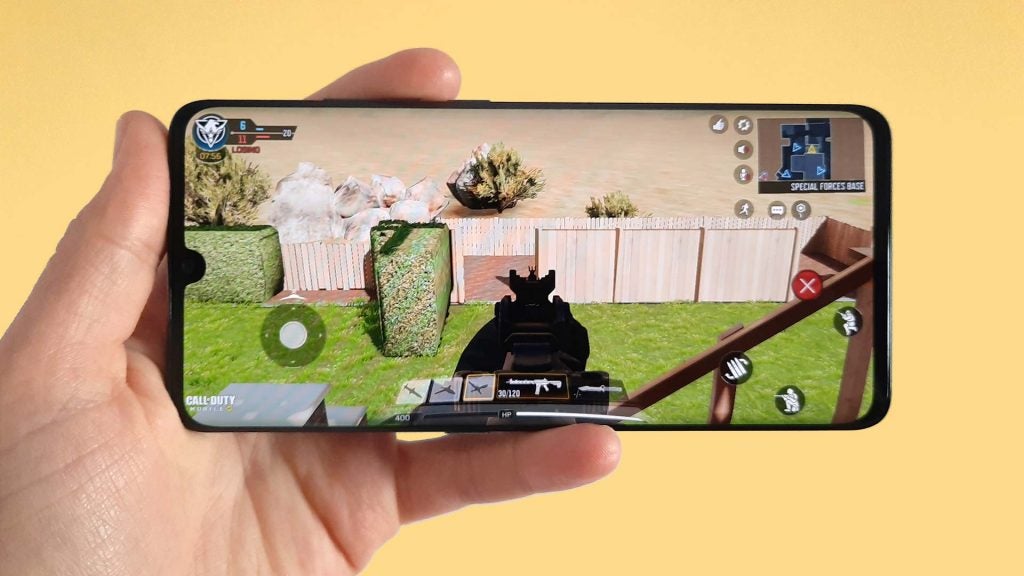
I’d rather have a phone with a Snapdragon 865, but the TCL 10 Pro is still great for gaming.
The speaker is the most obvious let-down while playing. Its one-sided delivery, firing from the bottom, is obvious. In addition, the speaker’s tone is thinner than many.
TCL 10 Pro camera – It doesn’t quite hit the heights of rival cameras
The TCL 10 Pro has four cameras arranged in a smart-looking line along its rear. Only two of them feel essential, though, as with many quad-camera phones at this level.
There are standard and ultra-wide views, but no zoom. The third and fourth cameras are 2-megapixel sensors for background blur photos and a 5-megapixel macro.
Macro photos are passable, with greater close-up detail than you’d see from the main camera. However, the macro isn’t good enough to make me want to actually use it regularly. Portrait depth images aren’t great, either. Too often you’ll see images that look unnatural thanks to dodgy depth mapping.
This is no great surprise when companies such as Huawei and Samsung have made far more high-end phones. The development has justified spending big on optimising depth-mapping algorithms, for example.
 The macro camera does let you shoot ultra-close shots such as this; but the results can be disappointing
The macro camera does let you shoot ultra-close shots such as this; but the results can be disappointing Relatively low-end camera hardware doesn’t quite do justice to the texture of these petals and the stamen detail
Relatively low-end camera hardware doesn’t quite do justice to the texture of these petals and the stamen detail 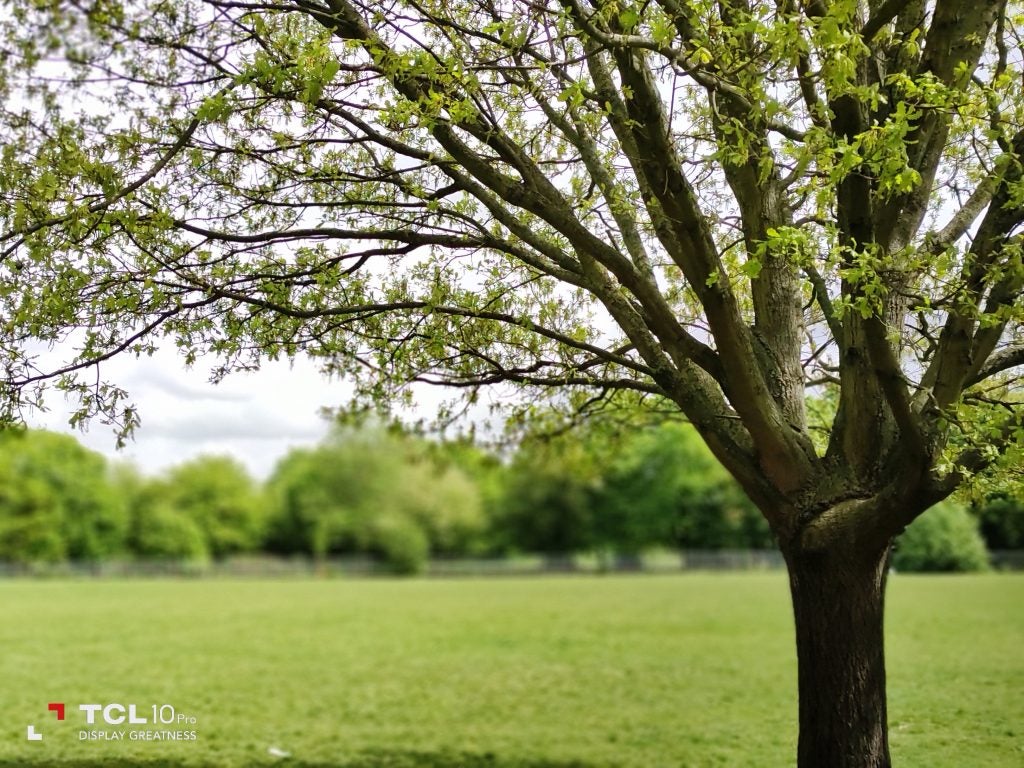
The portrait (background blur) mode struggles with more complicated scenes
The TCL 10 Pro’s “extra” cameras aren’t big hits then, but the other two fare better.
Our main camera has a 64-megapixel Samsung S5KGW1 sensor, a large 1/1.72-inch 64-megapixel chip. It’s used across a bunch of Xiaomi phones including the Remi Note 9 Pro, but only one Samsung line to my knowledge – the Galaxy A71. Despite being rich in megapixels, Samsung doesn’t use it in its top-end phones.
However, image quality is decent with some caveats. I’ll deal with the good bits, then move to the issues.
The TCL 10 Pro offers solid dynamic range enhancement, and is particularly adept at bringing out shadow detail. You can shoot right into the sun and get usable photos, so you don’t have to worry about the direction of light as much as you may with a dedicated camera.
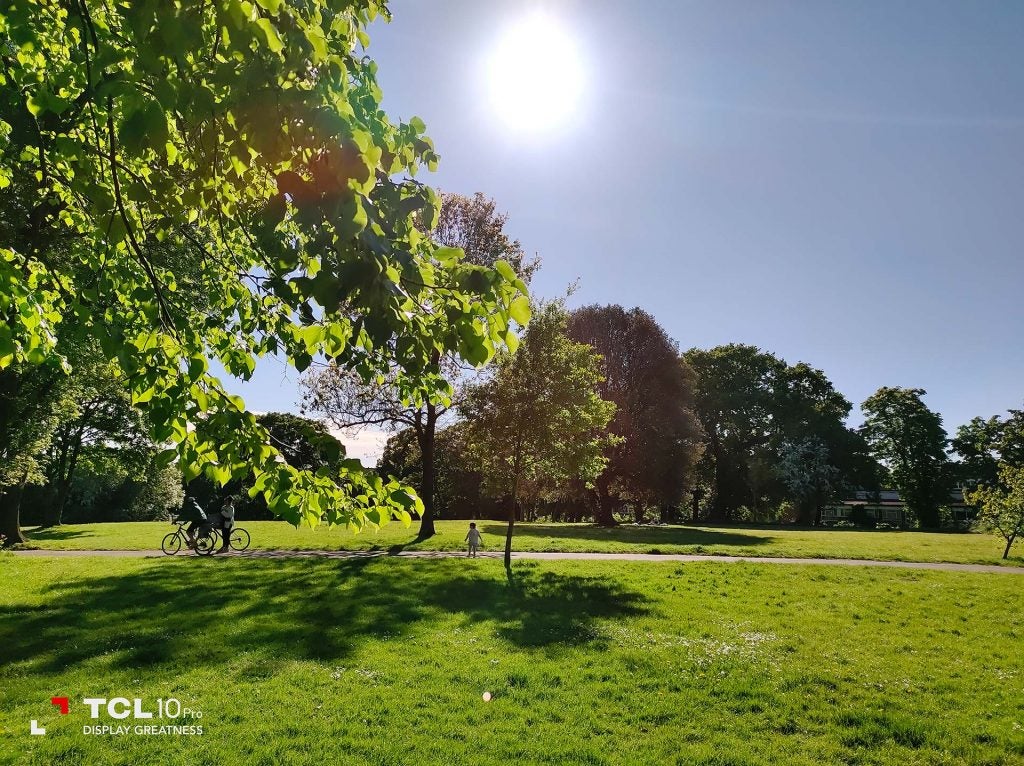
Colours are bold and vibrant. While they might appear a little juiced-up compared to those seen on the Google Pixel 3a XL or Xiaomi Note 10, they’re not distractingly overdone.
The phone’s 64-megapixel mode deconstructs how the camera is designed to operate, and likely uses a composite of multiple exposures given how long it takes. But they do look appreciably better down at pixel level.
Image quality of the ultra-wide camera is decent, too. It uses the 16-megapixel Samsung s5K3p9 sensor (1/3.1 inch). Hardware is less advanced and images tend to display a fine mist of grain across them; but this is only visible on zooming. Day-lit ultra-wide images are entirely usable, and having a second field of view is always welcome.
The TCL 10 Pro starts to seem less impressive when compared to the best-in-class phones.
Its exposure metering leans slightly too much towards making your images bright and vivid. As a result, there are often small areas of overexposure even after the dynamic range processing has done its thing.
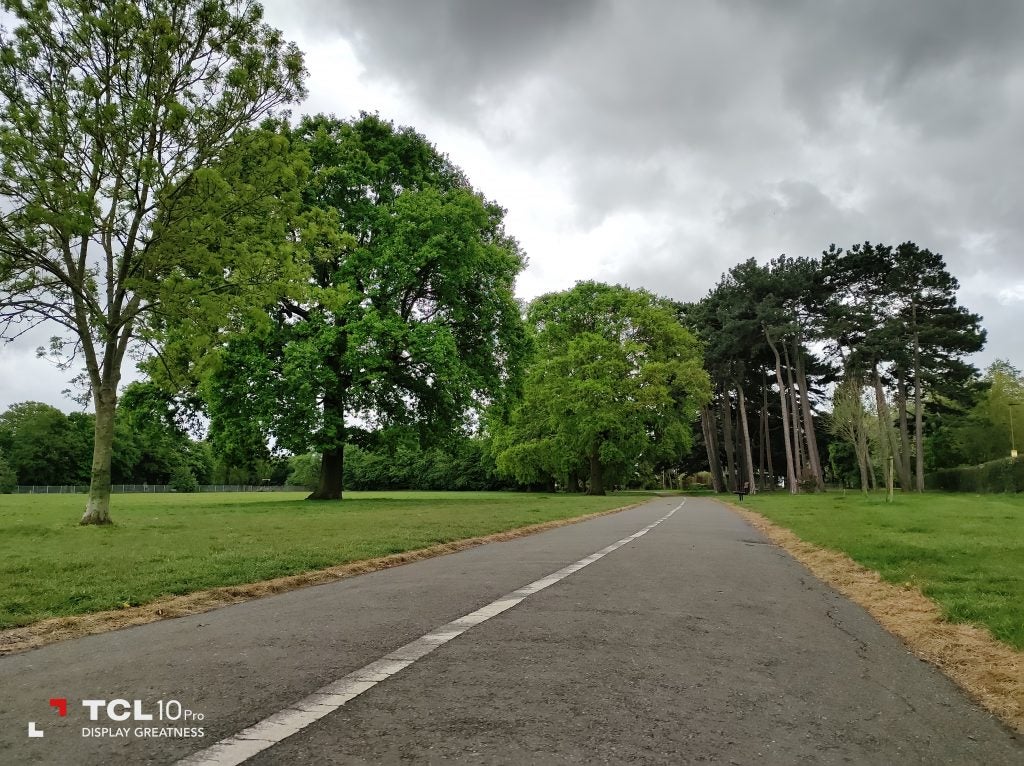
Less careful exposure handling than some causes overexposure issues, seen in the block white areas in the sky cover
In addition, general image processing isn’t nearly as good as that of Google, Xiaomi or Huawei phones at the price. Fine textures sometimes end up looking “painted”, turning gravel into brush strokes, and fine detail is over-sharpened.
The Google Pixel 3a XL and Xiaomi Mi Note 10 are considerably better in this respect. It’s no disaster for the TCL 10 Pro’s camera, though, since it’s able to render better shadow detail than the Samsung Galaxy A51.
I’d expect this area of TCL phones to improve if the company continues in its attempts to become a bigger player in own-brand phones. And it may even get better with software updates. Here are some comparisons, with a test scene:
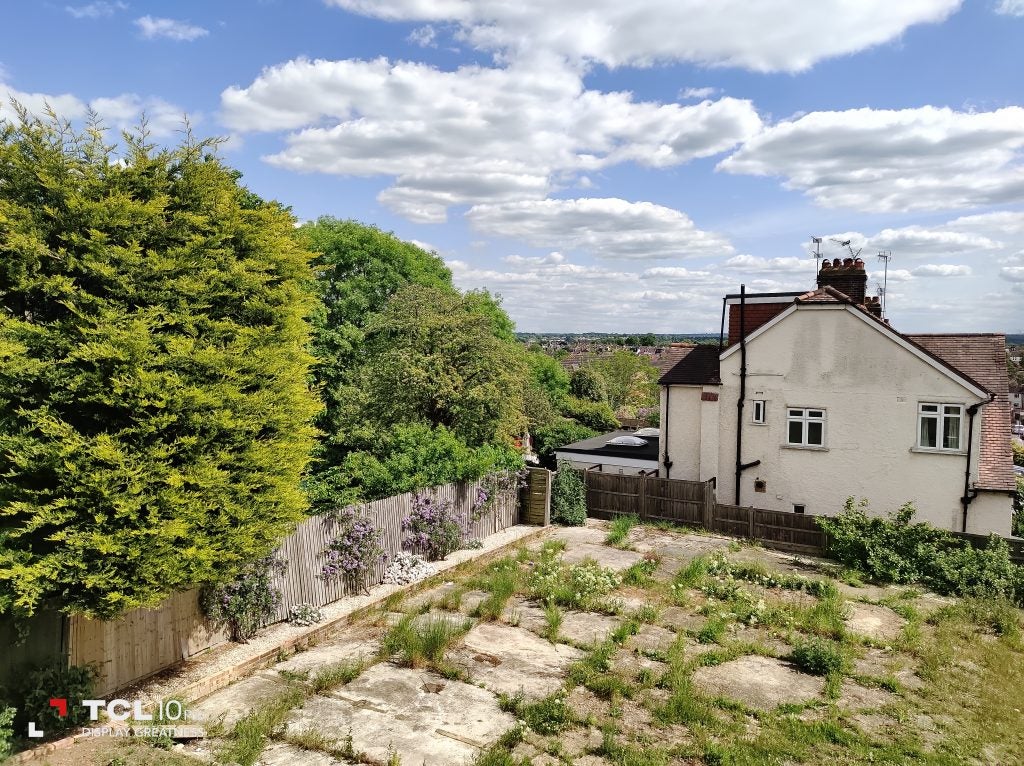
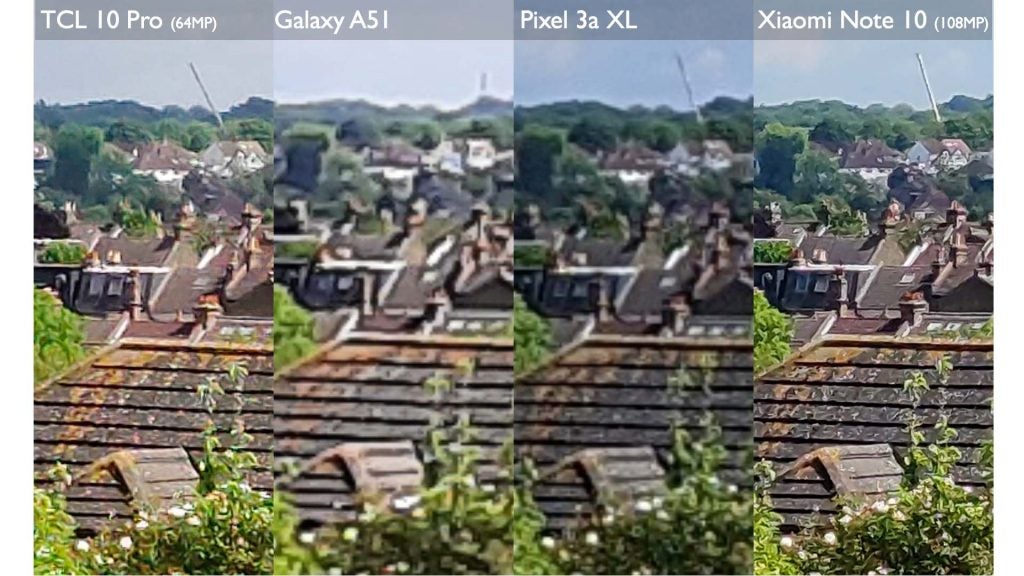
The TCL and Xiaomi high-res modes do have benefits if you need to crop into images post-shoot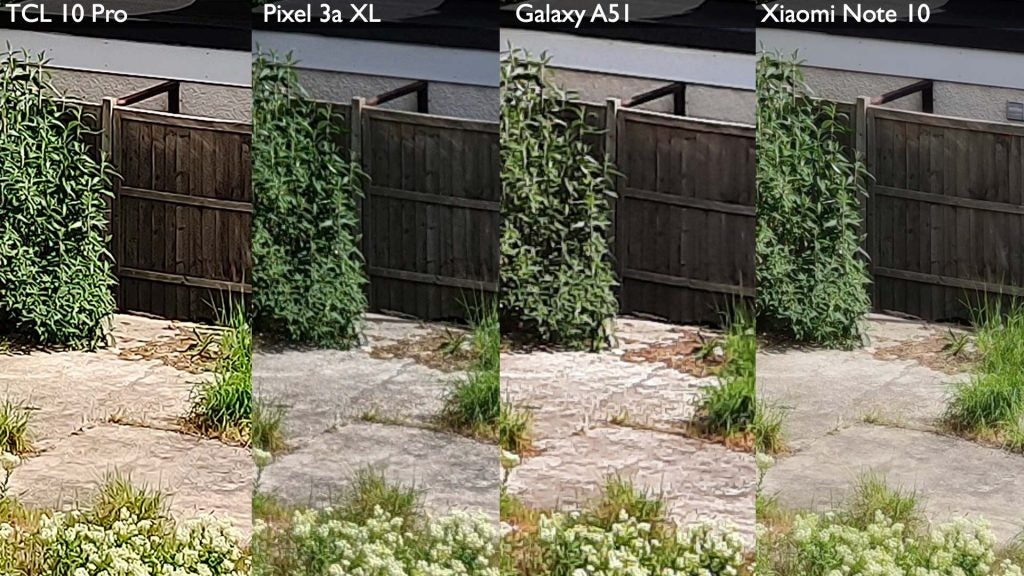 The Pixel and Xiaomi phones handle the texture of the rear wall and the concrete far better than the Galaxy or TCL. Also note how the leaves and grass look far more “stressed” than images from other phones, as a result of sharpening. Still, the TCL’s fence shows more detail than the Samsung Galaxy A51’s.
The Pixel and Xiaomi phones handle the texture of the rear wall and the concrete far better than the Galaxy or TCL. Also note how the leaves and grass look far more “stressed” than images from other phones, as a result of sharpening. Still, the TCL’s fence shows more detail than the Samsung Galaxy A51’s.
The phone has a dedicated night mode, but it doesn’t come close to the Google Pixel 3a’s Night Sight offering. Night mode focuses on bringing out more shadow detail rather than using advanced computational photography techniques to improve detail and clarity. You can use it during the day, too, but this results in flat-looking images.
Night images are fairly poor, whether or not this specific mode is engaged.
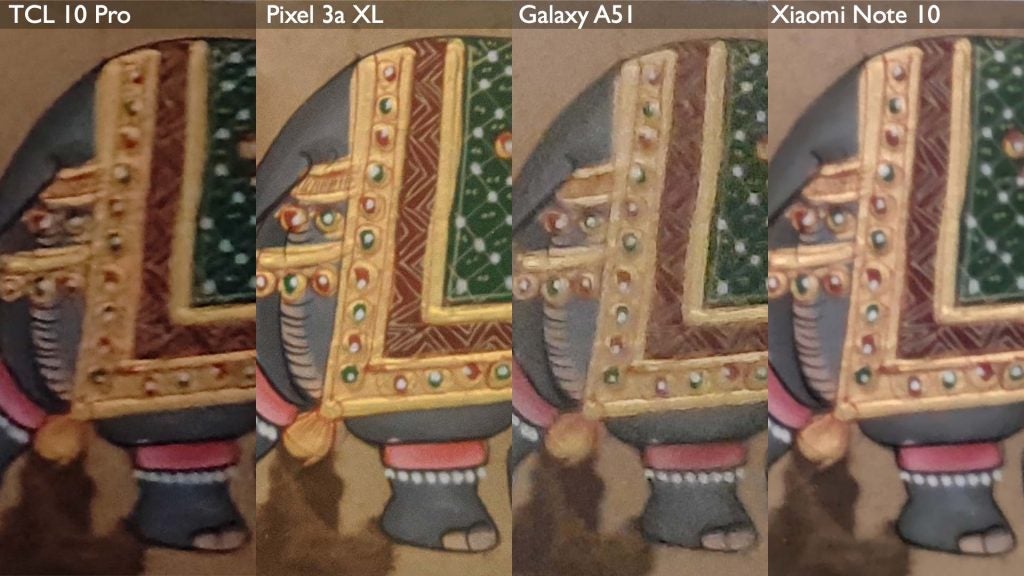
The Google Pixel 3a XL has a far better night mode than any of these phones. TCL’s 10 Pro brings up the rear, with a dim shot that features less detail than the rest, although it’s similar to the Galaxy A51, but darker.
There’s also a little shutter lag to the TCL 10 Pro camera. It’s only around a third of a second, but this is noticeable when comparing directly to phones from some of the better-known names.
While I have more complaints than praise for the TCL 10 Pro cameras, I’m mostly happy with their performance. TCL may have made BlackBerry phones for a few years, but as the first full TCL phone I’ve used, it’s reassuring to see its efforts aren’t miles behind the competition. Just several hundred metres.
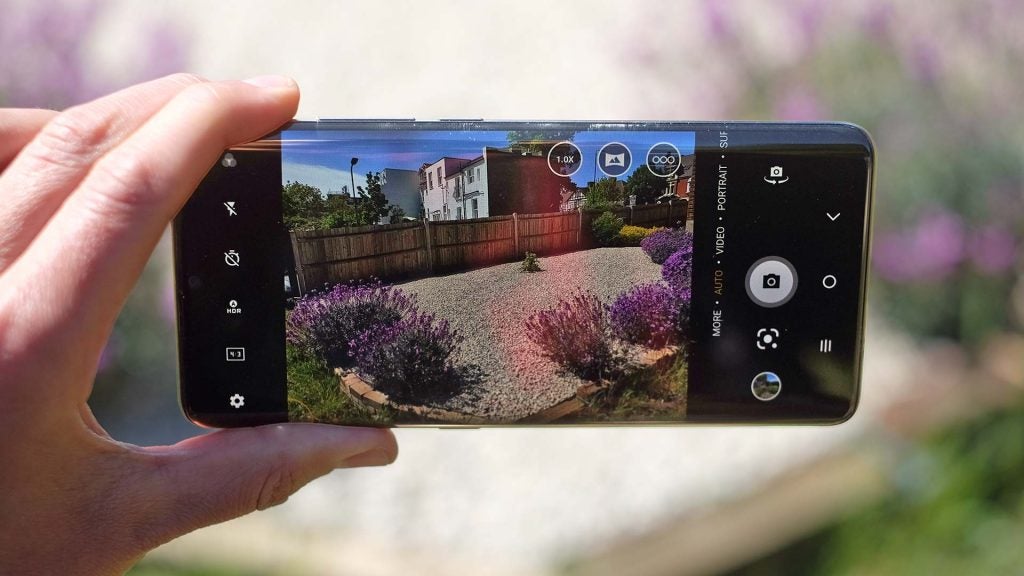
That said, this camera array isn’t as advanced at it looks. And don’t bother using the zoom. The app lets you go to 10x, but the results are awful. Here’s a demo shot, followed by a few more successful images taken with the TCL 10 Pro:

Is it a ladybird?
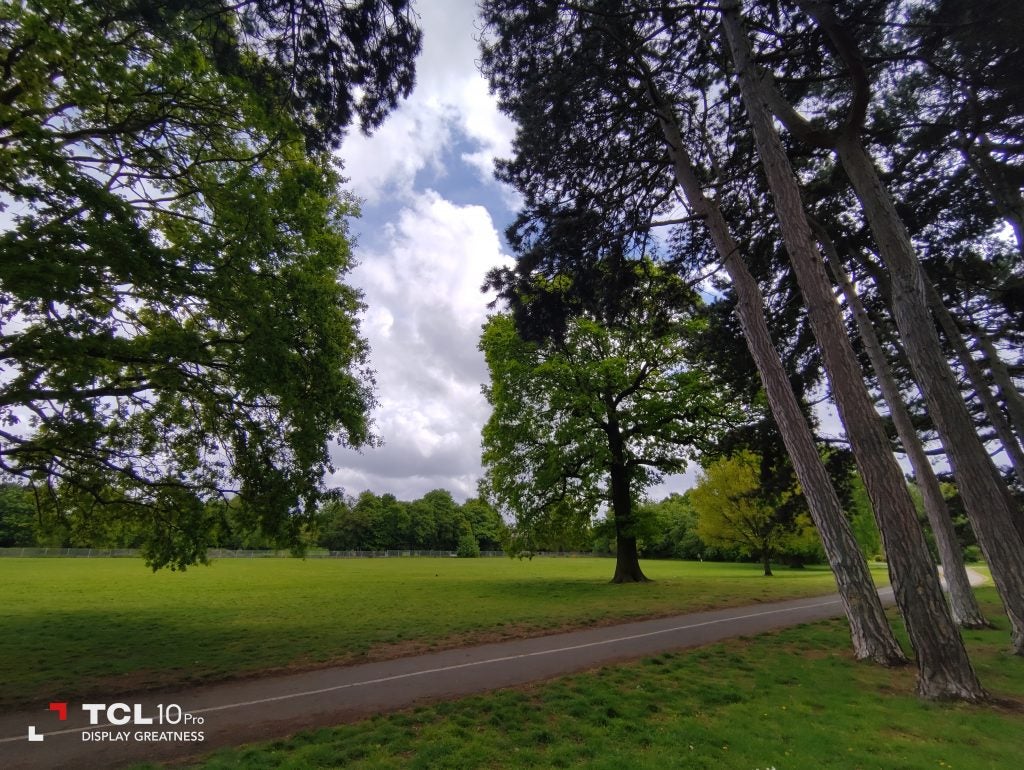
This image was taken with the ultra-wide camera
This shows off the phone’s handling of colour: a bit keen but pleasant
Video capture tops out at 4K resolution, 30 frames a second. And, unusually, there are no 60fps capture modes, even at 1080p or below.
However, 4K/30 does support electronic image stabilisation, which is a must if you want handheld footage to look smooth.
The TCL 10 Pro’s selfie camera uses a high-resolution 24-megapixel sensor, but it isn’t particularly impressive.
TCL 10 Pro battery life – Will get you to the end of the day, just
The TCL 10 Pro has a 4500mAh battery, a capacity that seems chosen to balance stamina with the phone’s thickness. I find the 5260mAh of a model such as the Xiaomi Note 10 more reassuring, but that phone is significantly thicker.
This phone’s stamina is passable, but little more. I find it claws its way to the end of the day, but often with under 10% charge remaining. This isn’t a handset on which you should rely on a long night out, or when GPS navigating through an unknown city all day long. Unless you bring an external battery, anyway.
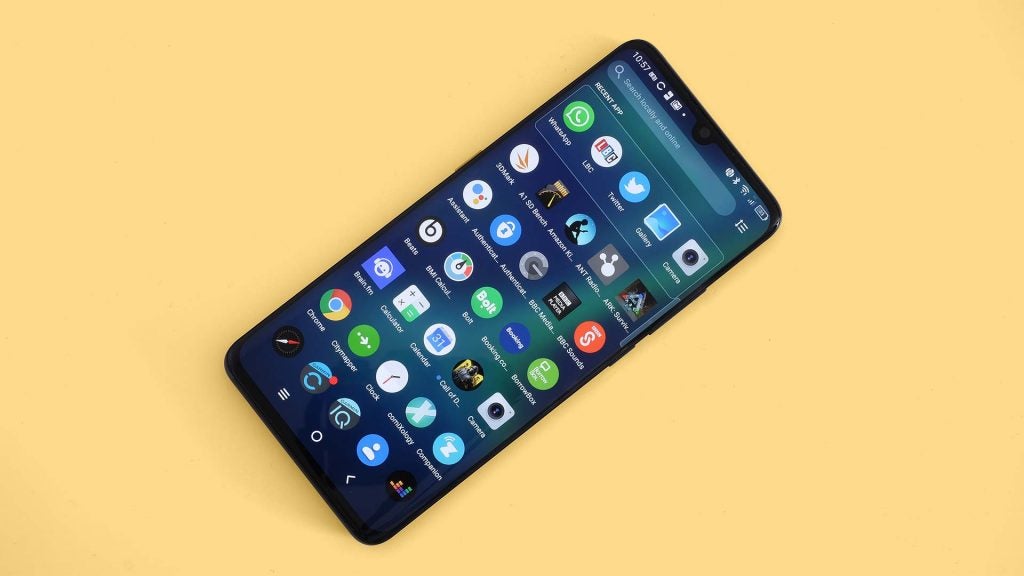
The TCL 10 Pro battery seems to underperform for its size, so I tried it out against the Google Pixel 3a XL and Xiaomi Mi Note 10 using Geekbench 4’s battery test. It came out with 5182 points, fewer than the Pixel’s 5344 – even though that phone has a smaller 3700mAh battery.
And the Xiaomi Ni Note 10? Unsurprisingly, it’s far ahead with 8513 points. These scores are abstractions, but provide a relative idea of the phones’ real battery life. The TCL 10 Pro’s should be at least a little better considering its 4500mAh capacity.
The phone does come with an 18W fast charger. It isn’t the most powerful around but still able to offer good speeds. From flat, a 30-minute top-up will get you to 43%. An hour so this figure reach 80%. No issues here; it’s fast enough for a mid-price phone.
There’s no wireless charging, but the TCL 10 Pro does support OTG charging. This lets you use the phone’s battery to charge other devices. It’s handy if you need to give your wireless headphones a quick boost.
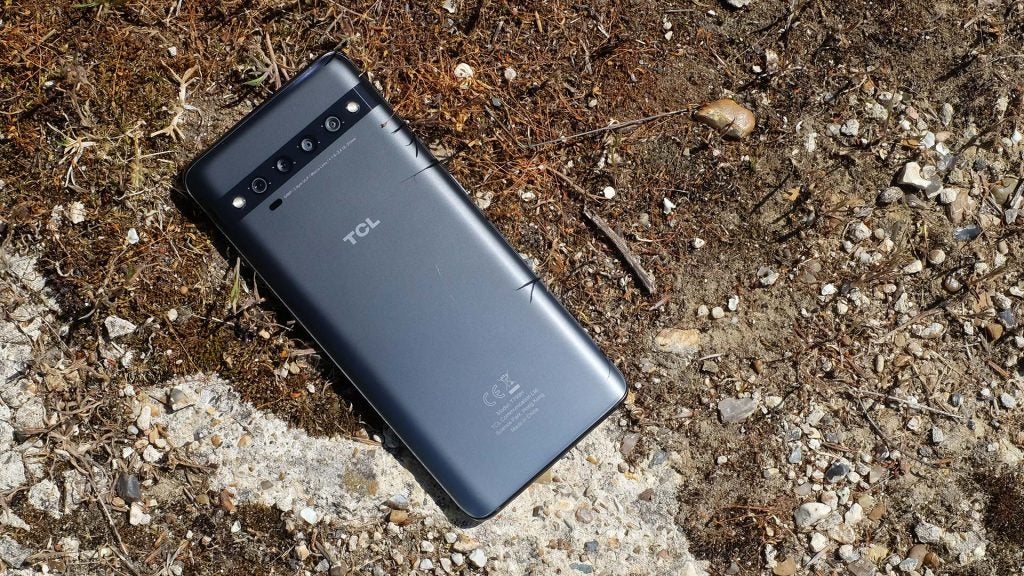
Should you buy the TCL 10 Pro?
If you’re looking for a phone that offers what OnePlus models once did then you may be mildly disappointed by the TCL 10 Pro. It doesn’t come housing a top-tier Qualcomm processor; just the kind you’d expect to see at the price and there are better best mid-range phones out there.
However, the TCL 10 Pro does have a lovely glass and metal build, plus an excellent curved OLED screen whose appearance isn’t too far away from phones in our best phone list. The 10 Pro is a high-class, lower cost phone of the type we mostly only see from Chinese brands these days.
A few issues stop it earning a higher score. Battery life should be better than it is considering the TCL 10 Pro has a solid Qualcomm CPU and a 4500mAh battery. There’s no zoom, and the cameras and image processing isn’t as good as that of the bigger names. This impacts low-light performance, too, which is fairly poor.
That said, this remains a decent phone if you’re wanting a curved OLED display at a sensible price. What’s essential is that you buy a case: while the matte glass finish looks and feels fantastic, it’s easy to damage.
How we test phones
We test every mobile phone we review thoroughly. We use industry standard tests to compare features properly and we use the phone as our main device over the review period. We’ll always tell you what we find and we never, ever, accept money to review a product.


